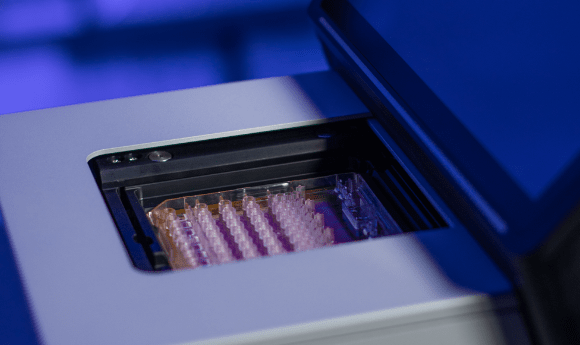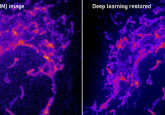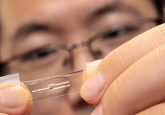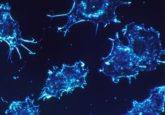Digital microfluidics and AI combine to provide an SPR system fit for the new decade

BioTechniques caught up with Ryan Denomme after his company, Nicoya, presented at SLAS 2020 (25-29 January 2020; San Diego, CA, USA), to talk about his presentation, Nicoya’s exciting new technology and his conference highlights.
Please introduce yourself and Nicoya
 My name is Ryan Denomme, I’m the CEO and founder of Nicoya based in Kitchener, Ontario (Canada). Nicoya was founded in 2012, just after I finished my Master’s in Engineering at the University of Waterloo. During my post-secondary education, I was frequently frustrated with researchers’ lack of access to cutting-edge technologies due to their overly expensive and complex features. I experienced first-hand how this lack of access directly and negatively impacted progress. This frustration motivated me to innovate and find a way to break down barriers between scientists and the data they need.
My name is Ryan Denomme, I’m the CEO and founder of Nicoya based in Kitchener, Ontario (Canada). Nicoya was founded in 2012, just after I finished my Master’s in Engineering at the University of Waterloo. During my post-secondary education, I was frequently frustrated with researchers’ lack of access to cutting-edge technologies due to their overly expensive and complex features. I experienced first-hand how this lack of access directly and negatively impacted progress. This frustration motivated me to innovate and find a way to break down barriers between scientists and the data they need.
Of all the technologies that support scientific research and discovery, surface plasmon resonance (SPR) stood out to me as being the most flexible and impactful technique to accelerate both academic research and drug discovery. I wanted to empower the scientific community with SPR data, so I integrated nanotechnology into traditional SPR sensors to make the localized surface plasmon resonance (LSPR) that is used in Nicoya’s products. This innovation enabled us to create OpenSPR, an affordable, benchtop and user-friendly SPR instrument.
Since launching OpenSPR in 2015, we have increased OpenSPR’s ability to generate higher quantities of more robust data while maintaining its compact size and affordable features (see OpenSPR-XT).
What did you present at SLAS 2020?
SLAS is the official launch platform for Alto – the world’s first SPR instrument powered by digital microfluidics (DMF). DMF-powered SPR provides numerous inherent benefits, including a significant reduction in sample volume, maintenance-free operation, more hands-off time, and better data quality. Alto offers a solution to the leading issues currently experienced with traditional SPR and we can’t wait to see what scientists can do with it.
It was the first time that the scientific community could hear how Alto was developed, how it can support their research projects, and what we imagine for the future. The presentation featured excerpts of how the technology functions and how their workflows will be improved as a result.
What sets this SPR system apart from current systems?
The most revolutionary aspect of Alto is that the integration of DMF has entirely removed the need for traditional fluidics. SPR’s complex fluidics requirements have inhibited anything more than incremental improvements to the technology. Alto’s DMF-powered SPR integrates the entire fluidics and sensor technology into one disposable cartridge. This enables users to eliminate maintenance and high-volume consumption from their workflows.
Additionally, 16 independently addressable channels present an opportunity to flexibly design high-throughput experiments. The data quality is improved by a reduction in human error and ability to precisely control nanoliter sample volumes. Finally, Alto will be just as user-friendly as our existing line of solutions.
Can you expand on the artificial intelligence aspect of this system, how does it assist the technology?
Typically, customers venture into designing their experiments by researching other publications and their successful conditions. Then, they have to experimentally test many different variables to determine the optimal conditions for the experiment, which is important to ensure high quality kinetics and affinity data. This is a highly time-intensive, iterative, expensive and error-ridden process. Researchers have to consider dozens of unpredictable variables before they even begin an experiment.
By creating a database of successful SPR experiments and conditions, we’ll first help users with “AI-Assisted Assay Optimization,” essentially assisting and suggesting reputable conditions for researchers to test first. This alleviates time spent researching and testing many different conditions. Paired with data analysis software, Alto can “remember” the conditions which produce successful results and continue learning to improve the accuracy of its suggestions. This further expands the possibilities. There are a lot of steps in SPR data analysis that are ripe for artificial intelligence/machine-learning disruption and we’re the first to tackle those.
What challenges did you encounter when developing this system?
Ultimately, the biggest challenge was integrating an entire fluidics and sensing technology onto one affordable cartridge. Both of these are extremely complex and sensitive features from an engineering perspective. This required significantly more collaboration between teams than previous products, and we really pushed the boundaries of what we thought would be possible.
What have been your highlights of SLAS 2020?
There were tons – but narrowing it down I’d say being able to hear the positive feedback on Alto from conference attendees. Our team has spent countless hours getting to this point, so being able to hear how Alto would solve existing issues of researchers/scientists was truly fulfilling. Other than that, giving away a free Alto during my presentation was definitely a highlight!





